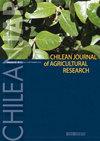Environmental factors and physiological responses of sweet cherry production under protective cover systems: A review
IF 1.7
4区 农林科学
Q2 Agricultural and Biological Sciences
引用次数: 1
Abstract
Climate change is increasing sweet cherry ( Prunus avium (L.) L.) production under cover systems such as high tunnels, rain covers, and nets. The objective of this review was to provide an overview of the environmental factors and physiological responses involved in cherry production under different types of protective covering systems. The most important environmental factors affected by cover systems are photosynthetically active radiation (PAR), temperature, relative humidity, and wind speed, which in turn affect leaf gas exchange, plant water relations, tree growth, flower development, and fruit quality. The use of covering systems has a positive effect on photosynthesis by increasing the amount of diffused PAR, but a negative effect on the reproductive-vegetative tree balance due to lower total PAR availability. Increases in air temperature by cover systems alter differentially flowering and fruit set, impacting positively the ripening time and cell division of the fruits. Plant water status is improved under cover systems, allowing for greater tolerance to water deficit as well as improved potential fruit cell expansion, with an ensuing positive effect on fruit size, but decreasing fruit firmness due to lower Ca availability fruits. The multiple environmental factors and physiological responses observed in cherry production under cover systems suggest the need to adjust agronomic practices such as pruning, crop load regulation, irrigation, and nutrition according to these specific conditions.保护罩条件下甜樱桃生产的环境因素及生理响应研究进展
气候变化增加了甜樱桃(Prunus avium, L.)L.在隐蔽系统下生产,如高隧道、雨罩和网。本文综述了不同保护层制度下樱桃生产的环境因素和生理反应。受覆盖系统影响最重要的环境因子是光合有效辐射(PAR)、温度、相对湿度和风速,它们依次影响叶片气体交换、植物水分关系、树木生长、花朵发育和果实品质。覆盖系统的使用通过增加扩散PAR的数量对光合作用有积极影响,但由于总PAR有效性降低,对生殖-营养树木平衡有负面影响。覆盖系统增加的气温改变了开花和坐果的差异,对果实的成熟时间和细胞分裂产生积极影响。覆盖系统改善了植物水分状况,提高了对水分亏缺的耐受性,并改善了潜在的果实细胞扩增,随后对果实大小产生积极影响,但由于果实钙有效性降低,果实硬度降低。覆盖下樱桃生产的多重环境因素和生理反应表明,有必要根据这些具体条件调整修剪、作物负荷调节、灌溉和营养等农艺措施。
本文章由计算机程序翻译,如有差异,请以英文原文为准。
求助全文
约1分钟内获得全文
求助全文
来源期刊
CiteScore
3.00
自引率
11.80%
发文量
60
审稿时长
6 months
期刊介绍:
ChileanJAR publishes original Research Articles, Scientific Notes and Reviews of agriculture, multidisciplinary and agronomy: plant production, plant protection, genetic resources and biotechnology, water management, soil sciences, environment, agricultural economics, and animal production (focused in ruminant feeding). The editorial process is a double-blind peer reviewing, Editorial Office checks format, composition, and completeness, which is a requirement to continue the editorial process. Editorial Committee and Reviewers evaluate relevance and scientific merit of manuscript.

 求助内容:
求助内容: 应助结果提醒方式:
应助结果提醒方式:


